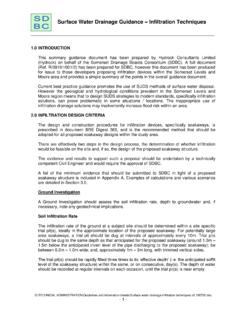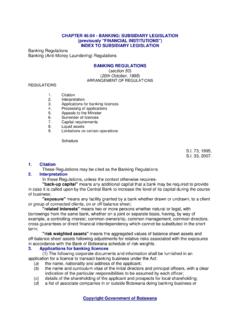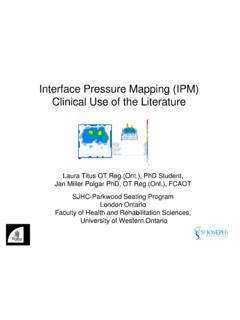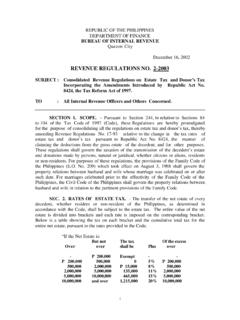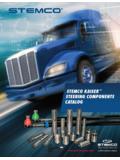Transcription of Development and Validation of a New Universal …
1 Development of a New Universal HPLC Detector: The Corona CAD. Darwin Asa Marketing Manager ESA Inc. Recently, a new Universal HPLC detection technology has been developed based on charged aerosol detection that has led to the Development of a Universal HPLC detector, the Corona CAD. To further understand the capabilities of charged aerosol detection and the use of the technology in an HPLC detector, the Corona CAD was tested for its sensitivity, dynamic range, response from compounds of different structures, and the instrument's reproducibility characteristics.
2 Sensitivity and dynamic range measurements of the Corona CAD were assessed by performing an analysis of a number of dilution series on various types of molecules (sugars, small molecules, etc.). The instrument response from various compounds was tested by injecting a series of compounds with widely divergent molecular structures in the Corona CAD at identical mass concentration. The reproducibility of the instrument was measured by repeat injections of identical samples. The Corona CAD was found to be able to consistently measure ng levels on column of various molecules.
3 The Corona CAD also exhibited very consistent (within 15%) quadratic response for a variety of compounds regardless of their chemical structure, with at least 4 orders of magnitude dynamic range, while providing RSDs routinely less than 2%. Materials and Methods A diagram of the Corona CAD instrument is shown in Figure 1. The detection method involves pneumatic nebulization of HPLC column eluent, exclusion of the largest droplets via an impactor, and ambient T solvent evaporation to form an aerosol of analyte particles. A turbulent jet of positive ions, formed by passing a secondary stream of gas by a corona discharge and through an orifice, is mixed with the opposing analyte aerosol stream.
4 In this process, charge is transferred diffusionally to analyte particles. Excess positive ions are trapped by a weak electric field and charged particles impinge on a conductive filter, which transfers the charge to an electrometer for signal transduction. Several CAD devices (Corona CAD, ESA Inc., Chelmsford, Massachusetts) were evaluated with a variety of HPLC systems, including Agilent 1100LC (Agilent Technologies, Wilmington, Delaware) and ESA HPLC systems. Nitrogen gas (ESA. nitrogen generator or cylinder), regulated at 35 psi was introduced to the detector and the resultant gas flow rate was regulated automatically and monitored by the CAD device.
5 The only parameter that required user input was response range, which typically was set to 100 pA full scale with 1 V analog output to the Agilent ChemStation or EZChrom Elite for ESA chromatography data systems. Studies of detection sensitivity, dynamic range response factors, and reproducibility involved both chromatographic and flow injection analysis (FIA) of compounds representing a wide diversity of chemical properties. Instrument sensitivity, dynamic range, response, and precision were evaluated for a variety of compounds and chromatographic conditions.
6 These conditions are described with the results section as appropriate. Results and Discussion Figure 2 shows the results of injecting dilution series from nanaogram to microgram concentrations of carbohydrates, small molecules, and phospholipids on the Corona CAD. In all cases the Corona CAD was easily able to quantitate molecules to low nanogram sensitivities. For example, when the carbohydrates were resolved on an analytical column, they could be readily detected at ng on column with a S/N ratio of at least 3:1. These results demonstrate that the Corona CAD is able to measure very low levels of a wide variety of compounds.
7 Table 1 summarizes the data obtained when injecting 17 chemically diverse compounds injected for testing the applicability and response factors of the Corona CAD. With the exception of naphthol, a volatile compound, all of the molecules tested were detected by the Corona CAD. These molecules included high MW compounds, neutral, acidic, basic, and zwitterionic small molecules, and carbohydrates. The ability of the Corona CAD to detect these molecules seems to be independent of compound structure. The exception found was with volatile compounds. Semi-volatile compounds showed a lower response on the Corona CAD.
8 As the Corona CAD is an evaporative technique, undoubtedly a significant portion of the molecule evaporates prior to detection. Most interestingly, when measuring the response factors of equal amounts of different compound, the mean response for all compounds ranged from ~ to million area units for the quantity injected. Response factors (peak height/mass injected) were relatively independent of chemical structure. Compounds as diverse proteins, small molecules, carbohydrates, etc. all seem to give a very similar response in the Corona CAD. Figure 3 represents the data obtained when measuring the dynamic response range of the Corona CAD.
9 As can be seen, the dynamic response range for the instrument was at least 4 orders of magnitude with on-column limits of detection in the 1-10 ng range for the compounds tested. Response from this type detector result in non-linear power function curves where y = axb where the value of b is less than 1 (experimentally shown to range from to ). The dynamic range is generally from about 10 ng to more than 100 g/ml for the compounds tested. To test the reproducibility of the Corona CAD, Figure 4 shows an overlay of five repeat injections of the three carbohydrates at 10 ng each on column compared with five repeat injections of blank diluent.
10 As can be seen, at 10 ngs injected, the repetitive injections of carbohydrates yielded relative standard deviations of , and , respectively when monitoring peak heights. When 25 g of the four carbohydrates were injected the average relative standard deviation was Conclusion The Corona CAD has been shown to be a potentially useful new detection technology. The results of this study indicate that the Corona CAD possess many of the important attributes desired in Universal detection including: broad applicability (can detect molecules as diverse as proteins and small molecules), consistent response factors (15%.)

